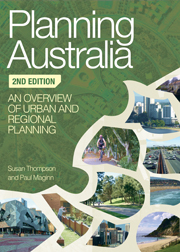Book contents
- Frontmatter
- Contents
- Contributors
- Figures and tables
- Discussion points and case studies
- Preface
- Acknowledgments
- Abbreviations
- Table of statutes
- Introduction
- Part I Frameworks
- 1 What is planning?
- 2 Planning and governance
- 3 Planning as a profession
- 4 An historical perspective
- 5 Statutory planning
- Part II Key Issues
- Index
- References
2 - Planning and governance
from Part I - Frameworks
- Frontmatter
- Contents
- Contributors
- Figures and tables
- Discussion points and case studies
- Preface
- Acknowledgments
- Abbreviations
- Table of statutes
- Introduction
- Part I Frameworks
- 1 What is planning?
- 2 Planning and governance
- 3 Planning as a profession
- 4 An historical perspective
- 5 Statutory planning
- Part II Key Issues
- Index
- References
Summary
Key terms: urban governance; urban management; government involvement in planning; planning powers; panels; centralisation.
Planning at both urban and regional levels across Australia exhibits several common features, shaped largely by the same challenges and managed through similar responses. Although they might seem numerous, the challenges for planners all relate to ensuring Australia’s environmental, economic and social sustainability– the so-called triple bottom line– at a time of global economic restructuring, environmental degradation and non-renewable resource depletion, rising levels of urbanisation and the apparent roll-back of principles of democratic government at all levels. At the same time, planners must also consider the needs, desires and expectations of current and future generations. The challenges that lie ahead for planners, politicians and Australian society are likely to be immense and increasingly complex given projected population growth– from around 22.7 million in 2011 (ABS 2011), to between ‘30.9 and 42.5 million people by 2056, and to between 33.7 and 62.2 million people by 2101’ (ABS 2008).
There is an integral relationship between sustainability issues and population patterns in Australia that frames the specific nature of the challenges faced by Australian planners, while their responses are shaped by the urban governance and urban management structures within which they work. In this context, ‘urban’ should not be understood as signifying that governance and management are purely issues for cities. Rather, governance and management responses are consequent upon the impacts of broader human settlement or development activity, irrespective of whether this occurs in city or rural locations. The scope and effectiveness of contemporary urban governance in Australia is closely related to the constitutional roles and powers of different levels of Australian government (Forster 2004). This area of governance has been characterised by changes in decision-making agents and structures, and such changes have been accompanied by increased supervision and scrutiny of government action. As the chapter explains the development of the various arrangements and relationships that characterise contemporary Australian urban governance and planning, it draws attention to the debates that have attended these developments.
- Type
- Chapter
- Information
- Planning AustraliaAn Overview of Urban and Regional Planning, pp. 34 - 55Publisher: Cambridge University PressPrint publication year: 2012
References
- 9
- Cited by



